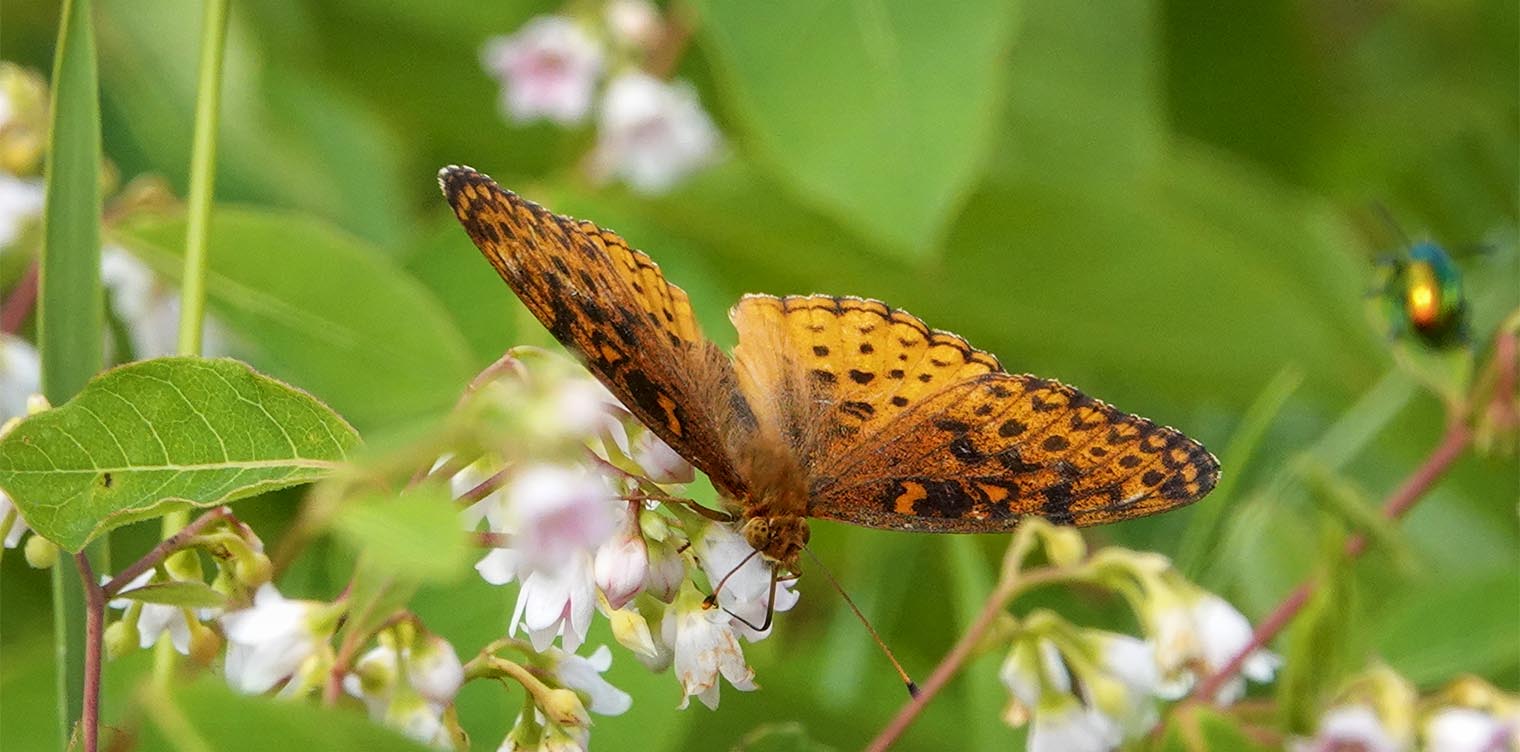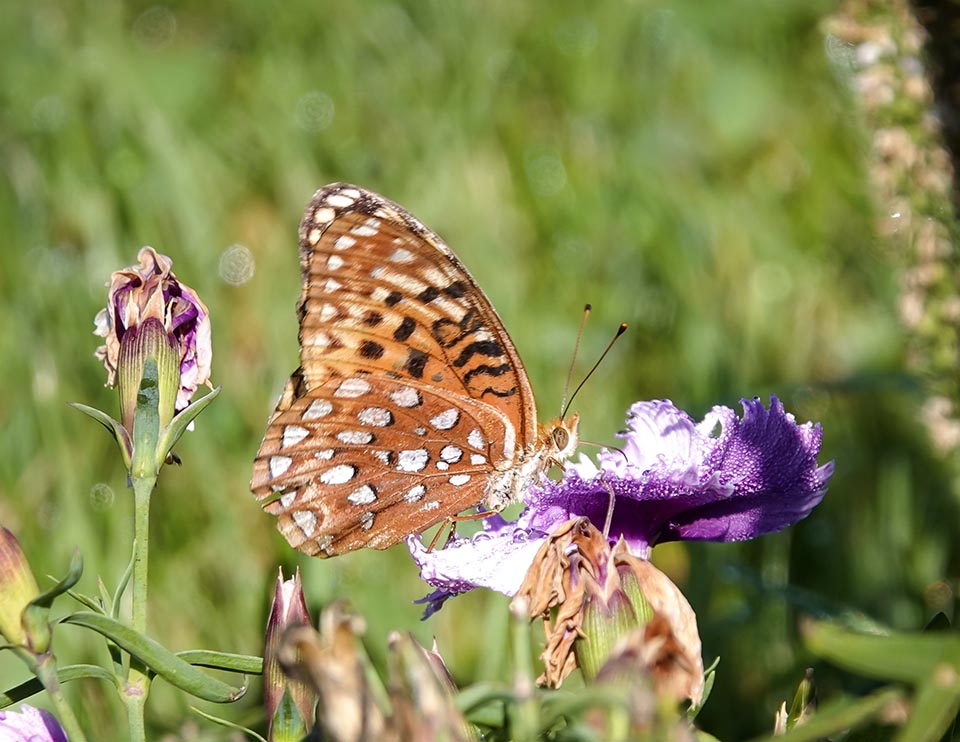Butterflies of the Adirondacks:
Aphrodite Fritillary (Speyeria aphrodite)

The Aphrodite Fritillary (Speyeria aphrodite) is an orange butterfly with many black dots and lines. It flies in the Adirondack Mountains of upstate New York in summer, mainly July.
The Aphrodite Fritillary was named after Aphrodite, the ancient Greek goddess of love, beauty, and fertility. [1] [2]
Aphrodite Fritillary: Identification

The appearance of the Aphrodite is geographically variable, which can make identification difficult. [3] [4] [5] The average wingspan of the Aphrodite Fritillary is 2.7 inches. [6] From above, the fore wing veins are lightly scaled with brown and there is generally a black dot near the fore wing base above the hind edge. [7] [8] [9] From below, the Aphrodite Fritillary's hind wing is cinnamon to chocolate-brown with silver spots. [10]
The Aphrodite is easily confused with both the Great Spangled Fritillary and the Atlantis Fritillary, both of which fly in the Adirondack Park around the same time. [11] [12]
- The Great Spangled Fritillary is somewhat larger than the Aphrodite [13] and lacks the black dot near the lower fore wing base. [14] [15] The tawny submarginal band on the hindwing underside is considerably narrower on the Aphrodite, as compared to the Great Spangled Fritillary. [16]
- Compared to the Atlantis Fritillary, the underside of the Aphrodite Fritillary is somewhat lighter. [17] [18] Moreover, in contast to the Aphrodite, the Atlantis Fritillary generally lacks the black spot at the base of the fore wing. [19]
- One useful identification feature to distinguish the three species is eye color. The Atlantis Fritillary has greyish blue eyes, while both the Great Spangled Fritillary and the Aphrodite Fritillary have brownish or yellow-green eyes. [20] [21]
Aphrodite Fritillary: Life History
Male Aphrodites patrol for receptive females during the warmer hours of the day. [22] [23] Females walk about on the ground to lay single eggs near violets. [24] [25] First-stage caterpillars do not feed, but overwinter until spring, when they eat young leaves of violets. [26] [27] Caterpillar hosts include various violet species. [28] [29]
Adult Aphrodites feed on a wide variety of mid- and late summer wildflowers, including Spreading Dogbane, thistles, milkweeds, clovers, and daisies. [30] [31] Active nectaring takes place in the early morning and the late afternoon. [32]
Aphrodite Fritillary: Habitat and Range
The Aphrodite has a wide tolerance of different habitats. [33] [34] It reportedly needs both open field for nectar and open woodland for larval growth on violets. [35] It may be found in wet meadows, wooded areas, open deciduous woods or coniferous woodlands, and prairie meadows. [36] [37] [38]
Aphrodite Fritillaries are fairly common across northern North America from the Rockies eastward. The range of this butterflies includes British Columbia east to Nova Scotia and south to east Arizona, Nebraska, and northern Georgia. [39]
Aphrodite Fritillary: Flight
The flight period of Aphrodite Fritillaries, as with all butterflies, varies with region and shifts from year to year. Most sources agree that this species has one brood, which flies from early summer through mid-September. [40]
- The flight period for Aphrodite Fritillaries in Massachusetts is from mid-June to mid-September. [41] [42]
- In Vermont, the Aphrodite Fritillary has one brood, which flies from mid-June through the end of September. [43]
- In Wisconsin, Aphrodites fly during most of July and August. [44]
- In the New York City area of New York State is from late June through early September, although this species has not been commonly seen there. [45] [46]
- Aphrodite Fritillaries are fairly common in Canada, usually flying in the months of July and August. [47] [48]
The flight period and abundance of the Aphrodite Fritillary within the Adirondack Park can only be roughly estimated, based mainly on verified sightings on Butterflies and Moths of North America (BAMONA) and reported observations on iNaturalist.
- The advantage of iNaturalist is that it is a popular citizen science web site that attracts many observers, in part because it covers both plants and animals and in part because the process of submitting an observation is very easy. The disadvantage is that an individual observation can achieve "research-grade" status by being confirmed by the observer and one additional individual, who may or may not have expertise in that particular taxa.
- The advantage of BAMONA is that sightings are verified by regional specialists who are recognized experts. The disadvantage is that there are fewer sighting records for most species, partly because the site covers only butterflies and moths and partly because the process of submitting a sighting is more complicated.
- Both data sets share a common problem of citizen science: reported trends may reflect trends in the number of observers and their willingness to submit reports, not the abundance of the butterfly in question. In addition, the Aphrodite Fritillary is quite similar in appearance to both the Atlantis Fritillary and the Great Spangled Fritillary and can be easily confused with these species if the observer does not have a clear view of the specimen. As a result, the number of recorded sightings may not reflect this species' abundance.
With these caveats in mind, it appears that Aphrodite Fritillaries in the Adirondack region usually fly from about late June to early September, with most sightings in July.
- Aphrodite Fritillaries were usually present in the Paul Smiths VIC Native Species Butterfly House and in the adjacent Butterfly Garden in late June, July, and August. [49]
- Most of the BAMONA-verified sightings for Aphrodite Fritillaries in the Adirondack Park counties suggest that this species is seen within the Blue Line mainly in July, with a few late June sightings and a few August sightings. [50]
- The pattern of research-grade iNaturalist observations indicates a similar pattern. Aphrodite Fritillaries are most commonly seen in July, although there are some August and early September sightings. [51] There are only 29 research-grade observations for Aphrodites in the Adirondack Park. [52] This compares with 36 Adirondack Park research-grade observations for Great Spanged Fritillaries [53] and 110 research-grade observation for Atlantis Fritillaries. [54] The most frequently observed butterfly in the Blue Line is the Monarch, with 412 research-grade observations. [55]
References
- Susan Grimm Hanley. Interpretive Naturalist, Paul Smith's College Native Species Butterfly House. Species Logbooks.
- Butterflies and Moths of North American. Species Profiles. Aphrodite Fritillary. Speyeria aphrodite. Confirmed sightings: 7/18/12; 7/18/12; 7/19/12; 7/28/12; 8/8/12; 8/20/12; 6/26/2013; 6/27/2013; 6/29/2013; 7/15/2013; 7/18/2013; 8/21/2013; 7/4/2014; 7/5/2014; 7/5/2014; 7/6/2014; 7/19/2014; 8/1/2014; 8/1/2014; 8/19/2014; 7/10/2015; 8/22/2015; 6/21/2016; 6/25/2016; 6/19/2018; 7/2/2018; 7/2/2018; 7/13/2019; 7/19/2019; 7/19/2019; 7/21/2019; 7/21/2019; 7/21/2019; 9/10/2019; 7/2/2020; 7/25/2020. Retrieved 9 July 2021.
- Government of Canada. Canadian Biodiversity Information Facility. Aphrodite Fritillary. Speyeria aphrodite. Retrieved 9 July 2021.
- Naturalist. Species Account. Aphrodite Fritillary. Speyeria aphrodite. Retrieved 9 July 2021.
- iNaturalist. Adirondack Park Observations. Aphrodite Fritillary. Speyeria aphrodite. Retrieved 9 July 2021.
- iNaturalist. Adirondack Park Observations. Atlantis Fritillary. Atlantis Fritillary. Speyeria atlantis. Retrieved 9 July 2021.
- iNaturalist. Adirondack Park Observations. Great Spangled Fritillary. Speyeria cybele. Retrieved 9 July 2021.
- iNaturalist. Adirondack Park Observations. Monarch. Danaus plexippus. Retrieved 9 July 2021.
- Massachusetts Butterfly Club. Massachusetts Butterfly Species List. Aphrodite Fritillary. Speyeria aphrodite. Retrieved 9 July 2021.
- Massachusetts Audubon. Butterfly Atlas Species Accounts. Aphrodite Fritillary Speyeria aphrodite. Retrieved 9 July 2021.
- The Butterflies of Massachusetts. Aphrodite Fritillary. Speyeria Aphrodite. Retrieved 9 July 2021.
- McFarland, Kent P. and Bryan Pfeiffer. Vermont Butterfly Survey. Vermont Center for Ecostudies – Vermont Atlas of Life. Aphrodite Fritillary. Speyeria aphrodite. Retrieved 9 July 2021.
- Maritimes Butterfly Atlas. Aphrodite Fritillary. Speyeria aphrodite. Retrieved 9 July 2021.
- Maritimes Butterfly Atlas. Atlantis Fritillary. Speyeria atlantis. Retrieved 9 July 2021.
- Wisconsin Butterflies. Aphrodite Fritillary. Speyeria aphrodite.
- Montana Field Guides. Aphrodite Fritillary. Speyeria aphrodite. Retrieved 9 July 2021.
- Iowa State University. Department of Entomology. BugGuide. Aphrodite Fritillary. Speyeria aphrodite. Retrieved 9 July 2021.
- University of Alberta. Department of Biological Sciences. E.H. Strickland Entomological Museum. Speyeria aphrodite. Retrieved 9 July 2021.
- Ross A. Layberry, Peter W. Hall, and J. Donald Lafontaine. The Butterflies of Canada (University of Toronto Press, 1998), pp. 168-169, Plate 12.
- National Audubon Society. Field Guide to Butterflies (New York: Alfred A. Knopf, 1981), pp. 546-547. Retrieved 9 July 2021.
- Jim P. Brock and Kenn Kaufman. Kaufman Field Guide to Butterflies of North America (Houghton Mifflin, 2003), pp.166-167.
- Paul A. Opler. A Field Guide to Eastern Butterflies (The Peterson Field Guide Series, Houghton Mifflin Company, 1992,1998), pp. 82-83, 238-239. Retrieved 9 July 2021.
- James A. Scott. The Butterflies of North America. A Natural History and Field Guide (Stanford University Press, 1986), pp. 324-325. Retrieved 9 July 2021.
- Jeffrey Glassberg. Butterflies through Binoculars. The East. A Field Guide to the Butterflies of Eastern North America (Oxford University Press, 1999), p. 104, Plate 28.
- Paul A. Opler and George O. Krizek. Butterflies East of the Great Plains: An Illustrated Natural History (The Johns Hopkins University Press, 1984), pp. 133-134, Plate 22 .
- Rick Cech and Guy Tudor. Butterflies of the East Coast. An Observer's Guide (Princeton University Press, 2005), p.164.
- Thomas J. Allen, Jim P. Brock, and Jeffrey Glassberg. Caterpillars in the Field and Garden. A Field Guide to the Butterfly Caterpillars of North America (Oxford University Press, 2005), pp. 80-81.
- Jeffrey Glassberg. Butterflies through Binoculars. A Field Guide to the Butterflies in the Boston-New York-Washington Region (Oxford University Press, 1993), p. 54, Plate 13.
